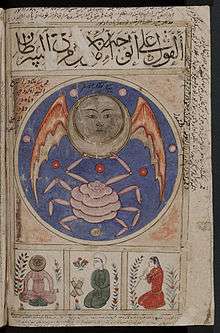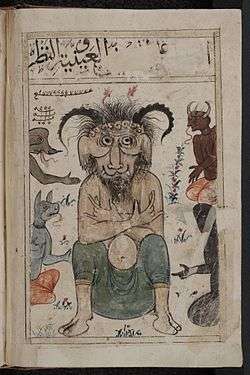Book of Wonders
The Kitab al-Bulhan (Arabic: كتاب البلهان, romanized: Kitāb al-Bulhān), or Book of Wonders, or Book of Surprises,[1] is a mainly 14th century Arabic manuscript compiled – and possibly illustrated[2] – by Abd al-Hasan Al-Isfahani. The codex was probably bound during the reign of Jalayirid Sultan Ahmad (1382-1410) at Baghdad, and includes texts on astronomy, astrology, geomancy and a section of full-page illustrated plates dedicated to each discourse topic, e.g. a folktale, a sign of the zodiac, a prophet, etc.[3][4]

History of Manuscript
The calligrapher, copiest and compiler, ʿAbd al-Hasan ibn Ahmad ibn ʿAli ibn al-Hasan al-Isfahani, whose family came from Isfahan in Iran and himself was a native of Baghdad, where he studied the Aristotelic ‘demonstrative’ (burhan) sciences.[5] It seems the Kitab al-Bulhan was commissioned by – or the idea of – Shaykh al-Diya Husayn al-Irbili’ (originally of Irbil near Mosul in northern Iraq), who sold it to Haydar ibn al-Hajji ʿAbd al-Karim ibn Muhammad in Dec 1409 - Jan 1410. The original codex comprised a series of treatises, which came apart, and when sections were reassembled and some lost, it became jumbled and incoherent. The work includes extracts copied from the Kitab al-mawalid (‘Book of Nativities’) of the astronomer and neo-Platonist Abu Maʿshar al-Balkhi (787-886 CE) of Balkh (modern-day Mazar-i Sharif) in northern Afghanistan.[5]
Manuscript copies
In the late 16th century, two Turkish copies were made from the original for the two daughters of the Ottoman sultan Murad III: Ayşe Sultan (c. 1582) and Fatma Sultan. These manuscripts are complete and establish the original order of the treatises of the Kitab al-Bulhan. The codices are now held at the Pierpont Morgan Library, New York City and the Bibliotèque Nationale, Paris.[6]
Gallery
 A man, mounted on a camel, killing a dragon with a lance.
A man, mounted on a camel, killing a dragon with a lance.

 The great wall of Gog and Magog
The great wall of Gog and Magog Capricorn (al-Gadī), a Zodiac sign
Capricorn (al-Gadī), a Zodiac sign Demonic jinn
Demonic jinn
See also
References
Citations
- Carboni, p. 22, La Trobe Journal.
- Carboni, p. 34, La Trobe Journal.
- Carboni 2007, p. 295.
- Isfahani (al-), Kitab al-Bulhan 1390.
- Carboni, p. 24, La Trobe Journal.
- Carboni, p. 25, La Trobe Journal.
Sources
- Kitab al-bulhan, Bodl. Or. 133.
- Carboni, Stefano (2007), Venice and the Islamic world, Yale University Press, ISBN 9780300124309
- Carboni, Stefano, The ‘Book of Surprises’ (Kitab al-bulhan)of the Bodleian Library (PDF), The La Trobe Journal
- Isfahani (al-), Abd al-Hasan (1390), Kitab Al-Bulhan (Arabic MS ed.), Baghdad: Archive.org—International Exhibition of Persian Art London 1931, p. 367
External links

- Complete digital copy at the Bodleian Library